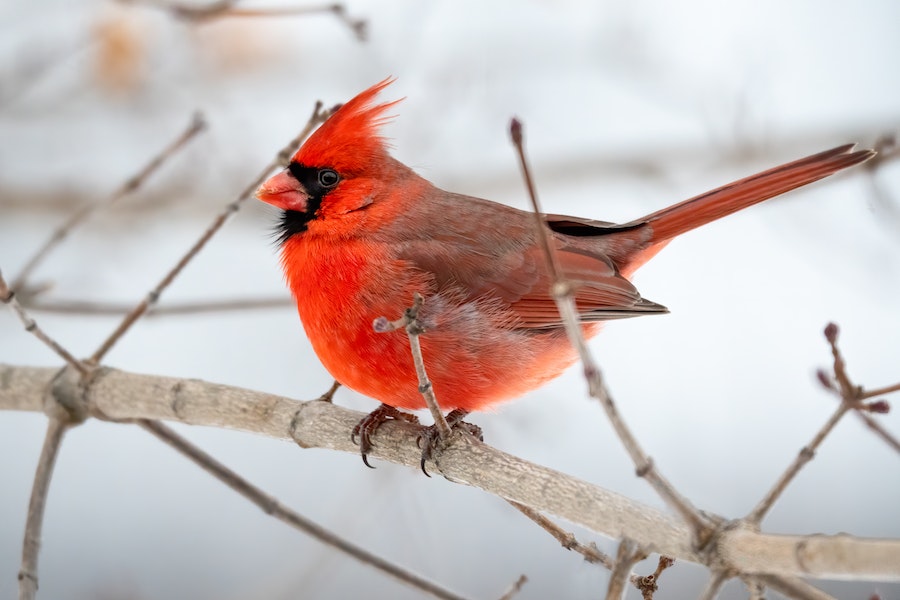Cardinals are renowned for their vibrant plumage and enchanting melodies, making them a beloved sight and sound in many backyards. While the striking appearance of adult cardinals is well known, the journey from hatchling to maturity remains a mystery to many. In particular, the appearance of baby cardinals is a fascinating aspect to explore. From their delicate size to the emergence of their feathers, observing the early stages of a baby cardinal’s life offers insights into their growth and development. In this article, we will delve into the world of baby cardinals, uncovering what they look like during their early days and shedding light on their remarkable transformation into the iconic songbirds they become.
What Does A Baby Cardinal Look Like?
A baby cardinal, also known as a nestling, has a distinct appearance that differs from its adult counterparts. These young birds are small and relatively plump, with soft, downy feathers covering them. Their eyes and ear canals are initially closed, and they rely on their parents for nourishment and protection. Baby cardinals lack the vibrant red plumage that defines adults, instead displaying a duller brownish coloration. As they grow, their feathers gradually develop, and they resemble adult cardinals more closely. Witnessing the adorable and somewhat unassuming appearance of a baby cardinal is a delightful experience that reveals the early stages of their remarkable journey toward maturity.
The Life Cycle Of Cardinals
The life cycle of cardinals encompasses various stages, each playing a crucial role in the survival and development of these remarkable songbirds. Here is an overview of the cardinal’s life cycle:
Breeding Season: Cardinals typically begin their breeding season in early spring. Male cardinals engage in vibrant singing and display behaviors to attract a mate. Once a pair forms, they establish and defend their nesting territory.
Nest Construction: The female cardinal takes the lead in nest construction. She builds a cup-shaped nest made of twigs, grass, and leaves, typically situated in dense shrubs or trees. The nest is carefully woven and lined with softer materials such as rootlets, pine needles, and feathers.
Egg-laying: After the nest is completed, the female lays a clutch of eggs. Cardinal clutches usually consist of 2-5 eggs, with each egg being light blue or greenish-blue in color. The female incubates the eggs while the male provides food for her during this period.
Incubation: The incubation period lasts around 11-13 days. During this time, the female remains dedicated to keeping the eggs warm, rarely leaving the nest. The male cardinal continues to supply food to sustain the female.
Hatching: Once the incubation period ends, the eggs hatch and the nestlings emerge. Newly hatched baby cardinals are blind, featherless, and dependent on their parents for warmth, protection, and nourishment.
Nestling Stage: As nestlings, baby cardinals proliferate. They develop a covering of downy feathers, eyes, and ear canals open, and their beaks become stronger. Both parents actively feed the nestlings with a diet consisting of insects, seeds, and berries.
Fledging: After approximately 9-11 days, the nestlings are ready to leave. This stage, known as fledging, marks the transition from being dependent on their parents to exploring the world independently. The fledglings continue to be fed by their parents while gradually learning essential survival skills.
Independence: Over the next few weeks, the young Cardinals become increasingly independent. They learn to forage for food, establish territories, and refine their flying and vocal abilities. During this period, the fledglings gradually acquire their distinctive plumage and reach sexual maturity.
Characteristics Of Baby Cardinals
Baby cardinals, also known as nestlings, possess distinct characteristics that differentiate them from adult cardinals. Here are some key traits of baby cardinals:
Size And Weight:
Baby cardinals are small and compact, typically 3 to 4 inches long. They have a plump appearance due to their underdeveloped musculature and body structure. The weight of a baby cardinal ranges from 0.4 to 0.6 ounces.
Downy Feathers:
Nestlings are covered in soft, fluffy down feathers. These feathers provide insulation and help regulate their body temperature. The downy plumage is often light gray or beige, giving the nestlings a somewhat fuzzy appearance.
Closed Eyes And Ear Canals:
Newly hatched baby cardinals have closed eyes and ear canals. This lack of sensory perception limits their ability to see and hear their surroundings. However, as they grow, their eyes and ear canals gradually open, allowing them to perceive the world around them.
Lack Of Feathery Crest And Bright Colors:
Unlike adult cardinals, baby cardinals lack the iconic feathery crest on their heads. Additionally, their plumage is predominantly brownish or grayish, with less vibrant colors compared to the vivid red plumage of adult males or the subtler red hues of adult females.
Dependence On Parental Care:
Nestlings rely entirely on their parents for nourishment, protection, and warmth. The male and female cardinals take turns feeding the nestlings a diet of insects, seeds, and berries. The parents also maintain the nest’s cleanliness by removing waste the nestlings produce.
Rapid Growth And Development:
Baby cardinals experience rapid growth during their nestling stage. They gain weight quickly, and their feathers gradually develop, transitioning from downy to more structured feathers. As their feathers grow, they begin to resemble adult cardinals more closely.
Behavior And Interaction With Siblings
Behavior and sibling interactions play an essential role in the development and social dynamics of baby cardinals. Here are some critical aspects of their behavior and interactions:
Baby cardinals typically hatch from the eggs within a similar timeframe, resulting in a clutch of siblings. These siblings bond through shared experiences, such as huddling together for warmth and protection. They often exhibit behaviors like cuddling, preening each other, and engaging in gentle play.
Sibling interactions involve competition for food from their parents. When the adult cardinals arrive at the nest with food, the nestlings engage in vigorous begging behavior, flapping their wings, opening their beaks wide, and emitting high-pitched calls. The more vocal and active nestlings often receive more attention and food from the parents.
Baby cardinals rely on their parents for nourishment and care. Siblings may take turns or alternate in receiving food from the parents, ensuring fair distribution and reducing competition within the nest. This cooperative behavior helps maintain the well-being of all the nestlings.
As the nestlings grow, sibling rivalry may emerge. As they become more independent and develop their flight and foraging skills, competition for resources, including food and space within the nest, can increase. This rivalry can lead to occasional squabbles or even displacing each other within the nest.
Siblings provide opportunities for learning and socialization. They observe and imitate each other’s behaviors, such as preening, stretching wings, and practicing flight maneuvers. Through these observations and interactions, they acquire essential skills for survival in their future independent lives.
Interacting with siblings helps baby cardinals develop vital social skills. They learn essential communication cues, body language, and vocalizations from each other, which are crucial for establishing territories, attracting mates, and interacting with other cardinals as they reach adulthood.
Feeding And Parental Care
Feeding and parental care are essential aspects of the survival and development of baby cardinals. Here’s a closer look at how feeding and parental care occur:
- Both the male and female cardinals participate in providing care for their nestlings. The male cardinal often takes the lead in searching for food, while the female remains with the nestlings, maintaining the nest and ensuring their well-being.
- Baby cardinals rely entirely on their parents for sustenance. The parents primarily feed the nestlings a diet of insects, caterpillars, spiders, seeds, berries, and fruit. They gather food from nearby sources and deliver it directly to the nest. The parents may regurgitate partially digested food to make it easier for the nestlings to consume.
- When the adult cardinals arrive at the nest, the nestlings exhibit begging behavior to signal their hunger. They open their beaks wide and emit high-pitched calls, indicating their readiness to receive food. The parents respond by placing the food directly into the mouths of the nestlings.
- Baby cardinals require frequent and regular feedings to support their rapid growth. Initially, the parents may feed the nestlings every 10-15 minutes, gradually reducing the frequency as the nestlings grow older. As the nestlings approach the fledgling stage, the intervals between feedings may extend to allow for increased independence.
- The adult cardinals also provide protection and security for the nestlings. They actively defend the nest and the surrounding territory against potential predators, such as snakes, squirrels, or other birds. The parents use alarm calls and engage in aggressive displays to deter threats and ensure the safety of their young.
Conclusion
A baby cardinal, also known as a cardinal nestling, possesses distinct features that set it apart from adult cardinals. These young birds are born with a relatively underdeveloped appearance, covered in a layer of soft, downy feathers that usually appear grayish or brownish. Their eyes are closed initially, but as they grow, they gradually open their eyes to reveal dark, beady orbs. Unlike adult cardinals, baby cardinals lack the vibrant and iconic red plumage; instead, they exhibit more subdued hues, allowing them to blend in better with their surroundings and stay protected from potential predators.








